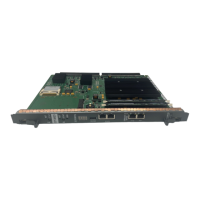96 Site planning
• If the handset users in cell 1C1 are all handset only users, one cell can
support 39 handset only users. Therefore, four cells are needed to
support 140 users (140÷39 = 3.5 cells).
•
If the handset users in cell 1C1 are handset and wired telephone
users, and one cell can support 83 users, two cells are needed to
support 140 handset and wired telephone users (140÷83 = 1.6 cells)
Procedure 28
High handset density deployment
Step Action
1 Determine the number of handset users in the high handset
density cell.
Count the number of users. Include users served by
through-the-floor coverage of this cell.
2 Calculate the cell subdivisions as required.
Divide the number of users by the appropriate value (12 or 20)
shown in Table 18 "Cell reengineering" (page 91). Round up the
result to the next whole number. The result equals the number
of cells required after subdividing the cell.
3 Divide the cell.
Draw lines from the cell center to the critical points on the cell
boundary. Shown in Figure 50 "Example of a subdivided cell"
(page 95), the cell 1C1 divides into four sectors and cell 1C2
divides into three sectors.
4 Relocate new cell centers.
Mark new cell centers within the sectored areas.
5 Determine the number of handset users in the new cell areas.
Count the number of user offices within each smaller sector.
Ensure there are fewer user offices within the cell than the traffic
limit.
6 Verify locations.
Take the deployment tool to the locations calculated on the floor
plan. Ensure that there is a location that meets the guidelines in
“Rules and guidelines to locate cell centers” (page 35).
7 Ensure the new cells have complete coverage.
Use the deployment handset to check coverage.
Nortel Communication Server 1000
SIP DECT Fundamentals
NN43120-123 01.07
6 January 2009
Copyright © 2008-2009 Nortel Networks
.

